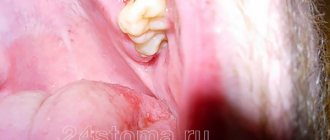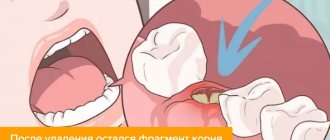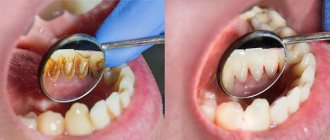Bleeding gums after tooth extraction is a natural process that usually does not require medical intervention. But in some cases, this phenomenon indicates serious tissue damage or other pathologies, and it will be almost impossible to stop the bleeding on your own. What to do if there is severe bleeding from the socket and when should you consult a specialist?
Gums bleed after tooth extraction
How long does it take to bleed after surgery?
Any surgical intervention, including tooth extraction, is associated with tissue trauma and damage to blood vessels - the teeth “hold” tightly to the tissue with their roots, so the doctor has to separate them using physical force. For this reason, it is simply impossible to do without blood during the procedure.
If your gums bleed after tooth extraction while you are at the dentist, the surgeon will help you on the spot
Normally, bleeding stops within 10-30 minutes after surgery - during this time the blood clots, and a clot forms in the socket, protecting it from infection. When removing teeth in the lower jaw, which dentists often call difficult, bleeding may take a little longer. After the initial bleeding stops, ichor may be released from the wound (do not mistake it for blood), so the saliva will be colored pink.
Removal of a wisdom tooth on the lower jaw
It should be noted that in some patients bleeding does not occur at all - this is due to the fact that adrenaline, which is released in the body or contained in anesthetics, causes temporary vasospasm. In such cases, there is a serious risk of developing alveolitis or the “dry socket” effect, since a protective clot does not form in the wound.
If the bleeding is strong enough and does not stop after using simple remedies, you should contact your dentist - you may need medical help to stop the bleeding.
There are many different reasons that lead to prolonged bleeding from a wound.
Perforation of the maxillary sinus: treatment
Conservative treatment for perforation of the maxillary sinus is indicated only in cases of its rapid detection. If it happens during the process of tooth extraction, the surgeon and the patient need to make every effort to keep the blood clot in the socket. To do this, apply an antiseptic turunda or alveolar bandage and secure it with sutures. The hole can be covered with fibrinogen-based glue, film or protective sheets. The patient is prescribed antibacterial therapy and vasoconstrictor drops are prescribed for instillation into the nose. It is important that for seven days he minimizes coughing, sneezing and blowing his nose - in this case, a hole with a diameter of up to five millimeters will close on its own.
Surgical closure of maxillary sinus perforation is recommended for holes of five millimeters or more that exist for more than twenty days. If foreign objects have entered the cavity, an operation is performed to remove them (sinusrotomy) in combination with plastic surgery of the perforation of the maxillary sinus using:
- Native tissue in the form of a buccal, alveolar, vestibular or combined flap, which is sutured to the wound edges;
- Synthetic materials in the form of plates of collagen, dura mater, bone matrix;
- Autografts in the form of fragments of the patient’s native bone, taken from the rib/chin/jaw and secured with steel screws.
You can make an appointment with CELT dental surgeons to eliminate perforation online on our website or by contacting our information line operators: +7 (495) 788-33-88.
Make an appointment through the application or by calling +7 +7 We work every day:
- Monday—Friday: 8.00—20.00
- Saturday: 8.00–18.00
- Sunday is a day off
The nearest metro and MCC stations to the clinic:
- Highway of Enthusiasts or Perovo
- Partisan
- Enthusiast Highway
Driving directions
Why is bleeding from a socket dangerous?
Intense bleeding from the gums often frightens patients - they fear dying from blood loss. However, the risk of death after tooth extraction surgery is minimal - this happens in isolated cases, and only with people who suffered from serious illnesses, alcoholism or drug addiction. But problems with internal organs and systems as a consequence of severe bleeding from the gums are quite likely, so it is not recommended to ignore severe bleeding.
Blood clot after tooth extraction
What factors are taken into account by the dentist when performing an intervention?
The likelihood of sinus perforation increases when the tooth root is located in close proximity to it at the time of extraction. Therefore, surgical treatment should be carried out with extreme care and subsequent X-ray monitoring of the tissue condition after surgery. The dentist also monitors the condition of tissues when using pins for implantation or when treating root canals for filling purposes, since there is a high risk of filling material and root fragments penetrating into the maxillary sinus.
If the process occurs at the time of implantation into bone tissue or when filling canals, then this is a direct mistake that is made by the doctor during his therapeutic tactics. The only way to control manipulations is X-ray control and the experience of the dentist, who, when working, must take into account the anatomical structure of the patient’s upper jaw. In this case, damage to the bottom of the sinus is fraught with serious complications that are difficult to eliminate. Especially if this happens during the implantation of artificial roots. The bone tissue in the upper jaw quickly undergoes degenerative changes, and this leads to a decrease in the height of the alveolar process.
When performing root resection to eliminate cystic formations, as in the above cases, the dentist must fully examine the patient. If the history is insufficient, perforation may occur in a situation where the doctor does not know the exact size of the bone plate that separates the bottom of the sinus from the wall of the cyst itself. In this case, the prognosis worsens if it is necessary to remove a large volume of bone tissue.
Causes of bleeding after tooth extraction
Bleeding after dental surgery is usually divided into primary and secondary - in the first case, blood flows immediately after the procedure, and secondary bleeding can develop several hours, sometimes several days after the visit to the clinic.
Bleeding after tooth extraction
There can be several reasons for primary bleeding, most of them are associated with pathological conditions of the body.
Table. Causes of primary bleeding after tooth extraction.
| Causes of bleeding | How to prevent |
| High blood pressure | Before going to the dentist, you need to measure your pressure and also take a sedative that will reduce the risk of it (pressure) increasing during the operation |
| Poor blood clotting in certain diseases (leukemia, hepatitis, hemophilia) | People with serious pathologies and hematopoietic diseases should report their problem to the doctor, who will choose the safest method of performing the operation |
| Taking medications | 2-3 days before tooth extraction, refrain from taking aspirin, heparin and other blood thinning drugs, as well as oral contraceptives (increased concentrations of estrogen in the blood in women can also cause bleeding) |
| Severe stress | If a person has a strong fear of dental procedures, a surge of adrenaline in the body can provoke bleeding - to prevent it, before visiting the dentist you need to try to calm down, and if necessary, take a sedative |
| Anatomical features of the dentofacial apparatus (large blood vessels on the surface of the gums) | Closely monitor the condition of the socket after surgery, avoid physical activity and follow the doctor’s recommendations |
- Why do my gums hurt after tooth extraction?
Another common cause of severe gum bleeding after tooth extraction is medical errors during extraction. Careless or too rough operation causes severe tissue trauma, which causes intense bleeding, and this situation is especially dangerous when large branches of the arteries are damaged.
Severe bleeding may be the result of a medical error
The main cause of secondary bleeding is patients’ failure to comply with the dentist’s recommendations: drinking hot drinks, solid foods, exposure to other traumatic factors, smoking, etc. In addition, blood from the socket can ooze in the event of complications developing - suppuration, alveolitis, the presence of cysts or granulomas. They impair coagulation at the site of inflammation, which leads to large blood loss both during and after surgery.
Alveolitis in the tooth socket
First aid at home
In order for the bleeding to stop, it is necessary to compress the blood vessels, but in such a way as not to cause additional trauma or damage to them and not to introduce an infection into the wound. Before carrying out procedures, wash your hands thoroughly with soap. Follow all the recommendations listed below with care.
At home, you can try to get rid of the problem in the following ways:
- tamponade the hole: for these purposes you can use a piece of sterile bandage or gauze. It is necessary to apply a tampon to the wound and close your jaws tightly. There is no need to apply pressure. Normally, the bleeding should stop within 15–20 minutes. For better effect and antiseptic treatment of the hole, you can pre-moisten the swab with hydrogen peroxide or in a solution of “Furacilin”,
- use a hemostatic collagen sponge: this is a specialized material impregnated with medications. You can purchase the product at the pharmacy. It’s better to stock up on it before the procedure, so that if necessary, everything you need is at hand. The advantage of such a sponge is that it has an immediate effect, disinfects, relieves signs of the inflammatory process, promotes rapid tissue healing, and also dissolves on its own. Price – from 100 rubles,
- take medicine for hypertension (for example, Captopril): if you have high blood pressure, then you need to bring your condition back to normal,
- apply a cold compress to your cheek: this is an excellent preventive measure against swelling and bleeding. Compresses constrict blood vessels and prevent the appearance of hematomas. Cold compresses are especially effective on the first day after extraction. Ice or any product from the freezer is suitable as cold, but before using it you need to wrap it in a towel or soft cloth. The time of one procedure is 10–15 minutes, then you need to take a break for half an hour and repeat according to the same scheme up to 4–6 times in a row.
Methods can be combined. You can combine socket tamponade with the use of cold compresses. Try to relax during the procedures. Don't be nervous, lie down. If there is no positive dynamics within an hour, then you need to call an ambulance or ask someone to take you to a doctor. Do not drive yourself, as general weakness due to blood loss can lead to decreased concentration.
When should you see a doctor?
In most cases, bleeding can be stopped using simple measures, but sometimes it requires immediate consultation with a doctor. You need to contact an emergency dental clinic if:
- the blood flows too intensely (the oral cavity fills with blood literally every few seconds);
- along with bleeding, a person experiences weakness and dizziness;
- the affected area is very swollen and painful;
- bleeding is accompanied by fever, difficulty breathing or swallowing;
- the patient experiences a severe headache and numbness in the areas adjacent to the affected area.
Phlegmon - acute extensive (spread) inflammation of fatty tissue
A variant of the norm is considered to be mild or moderate bleeding, which lasts no more than 24 hours; after the removal of third molars, this period increases to three days.
Photo of holes after tooth extraction
What can a doctor do?
In cases where it was not possible to stop the bleeding on your own, you should call an ambulance or go to the dental office. Doctors will examine the sore spot and prescribe one of the procedures aimed at stopping the bleeding:
- packing or suturing;
- cauterization of blood vessels;
- taking medications that improve blood clotting.
Tamponade bleeding
If the bleeding was not stopped in a timely manner, inflammation may begin in the hole - blood stops oozing from the wound, but the soft tissues begin to swell and hurt. If such symptoms appear, it is necessary to clean the hole, then fill it with a special anti-inflammatory agent and undergo a course of antibiotic treatment. If all of the above measures are ineffective, the patient is indicated for hospitalization.
After tooth extraction
How to prevent bleeding?
To avoid postoperative bleeding, you must refrain from the following actions:
- eat hard, rough, hot and cold foods;
- rinse your mouth intensively, especially with hot water;
- take a hot bath or visit a sauna;
- engage in heavy physical labor;
- actively use facial expressions (open your mouth wide, etc.);
- clean the affected area with a toothbrush, touch the wound with your tongue, fingers or foreign objects;
- smoke, drink alcohol;
- apply warm compresses to the cheek.
Normal socket healing
The above conditions must be observed for at least 24 hours (ideally 3 days) - this will help avoid not only bleeding, but also serious postoperative consequences.
In most cases, bleeding after tooth extraction is a normal physiological phenomenon that can be eliminated with simple home remedies, and if you follow all the doctor’s recommendations, the pain, fear and blood that accompany any operation will soon be left behind.
- What medicine is put into the hole after tooth extraction?









